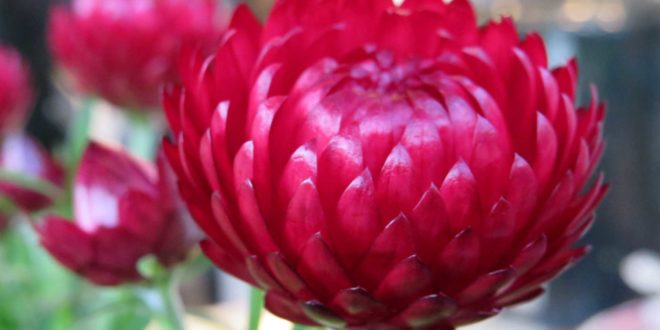Strawflower (Xerochrysum bracteatum) will bring vivid colors to your landscape and craft projects alike. Strawflowers resemble daisies in form, but unlike daisies, the petals are stiff and papery. In fact, they aren’t true petals at all, but modified leaves called bracts.
New to our Sunnyvale garden in 2020. Purchased from Yamagami Nursery. This red cultivar is Dreamtime Jumbo Red Ember.
Strawflowers were previously classified as a member of the genus Bracteantha but now are in the Xerochrysum genus. This Australian native is a part of the Asteraceae family, which includes many daisy-type flowers.
- Botanical Name Xerochrysum bracteatum
- Common Name Strawflower, golden everlasting
- Plant Type Annual flowering plant
- Mature Size 2 to 3 feet tall, 6 to 18 inches wide
- Sun Exposure Full sun, partial shade
- Soil Type Any well-drained soil
- Soil pH 5.5 to 6.5
- Bloom Time Spring, summer, fall
- Flower Color Yellow, orange, red, white, pink
- Hardiness Zone 8 to 10
- Native Area Australia
How to Grow Strawflowers
The strawflower can behave as a short-lived perennial in zones 8 to 11, returning reliably for two to three years. In most regions, however, gardeners start strawfloers from seed each year. The annual plants grow best in regions with hot summers, so if you have cool summers try growing the similar looking calendula instead. Varieties of strawflower over 3 feet tall may need staking, but the newest cultivars are bred to be stocky and early blooming and need no support.
Strawflowers are generally pest and disease-free, but aster yellows virus can affect the plants. This disease is most problematic in areas with leafhopper infestations, where the insect acts as a vector. Affected plants will exhibit yellowing of leaves and stunted growth. Remove infected plants and treat for leafhoppers with carbaryl or permethrin, if desired.
Light
Strawflowers thrive in full sun, although they can tolerate part shade. In the latter case, they won’t bloom quite as much. Growing strawflowers in full sun will help prevent flopping and weak stems.
Soil
Sandy and rocky soils are preferred over rich and heavy soils, but any soil is fine as long as excellent drainage is present. Add mulch to retain soil moisture and even soil temperatures. When planting in the garden, dig the soil to a depth of 10 to 12 inches and add 3 inches of compost.
Water
The drought-tolerant flowers will still be shining brightly in the garden after a week of summer vacation, but don’t let them wither in an extended period of drought. A weekly drink will keep the flowers pert and fresh. Give them about 1 inch of water a week during the growing season if the rain hasn’t already kept the soil moist. Don’t let the roots of the plant get overly soggy.
Temperature and Humidity
Sunflowers do best in temperatures of 65 to 70 degrees Fahrenheit during the day and 60 degrees at night. Strawflowers are not frost-tolerant, so they grow best in warm weather, and they prefer low humidity.
Fertilizer
Although not heavy feeders, a monthly application of balanced flower fertilizer will keep your strawflowers blooming steadily. Strawflowers grown in containers need more fertilizing than those planted in the garden.
Pruning Strawflowers
Strawflowers don’t need to be pruned regularly. However, deadheading the plant will keep the flowers blossoming.
Harvesting Strawflowers
Harvest flowers for drying when partially opened, as they will continue to open after picking. Collect the flowers in the evening, when they are free of dew. Strawflower stems are hollow and become brittle and shatter-prone after drying. The best way to use strawflowers in crafts is to remove the stems at harvest and use wires in their place. Strawflowers also look attractive as potpourri additions. The flowers feature excellent shape and color retention, even without a glycerin preservative.








